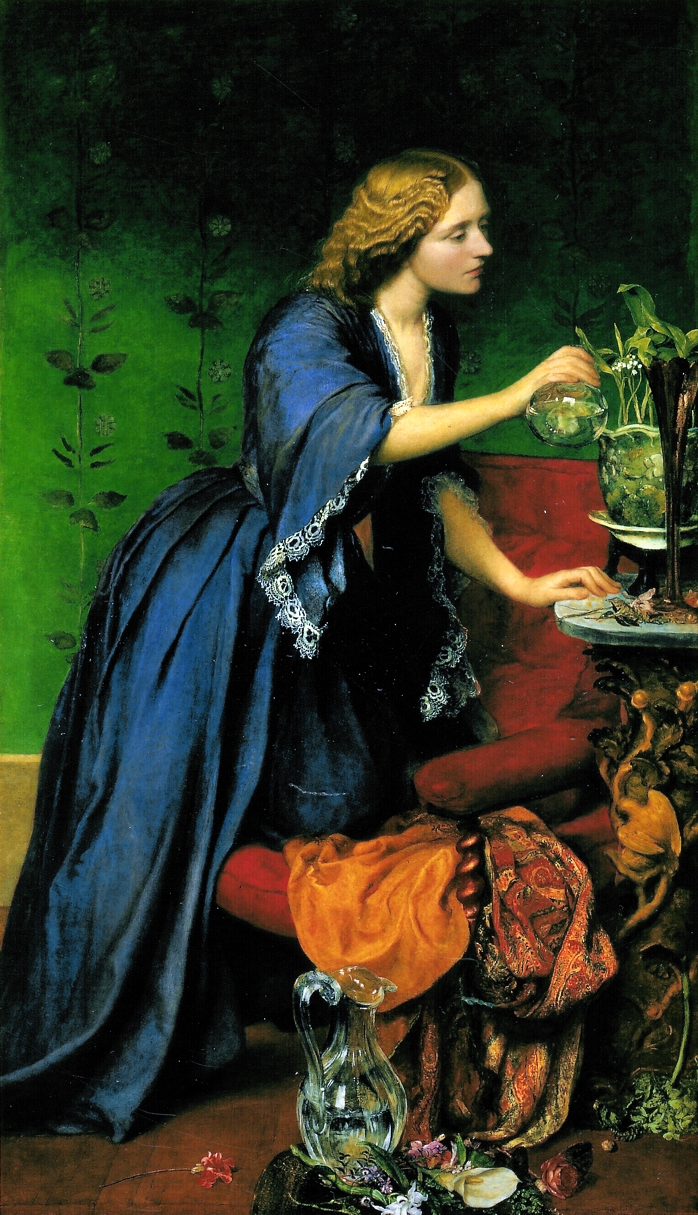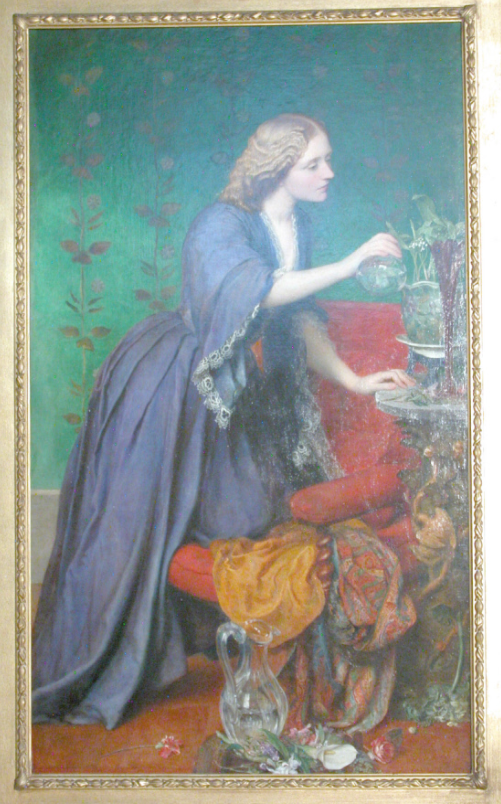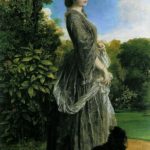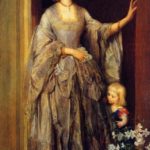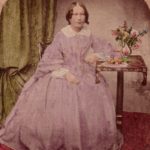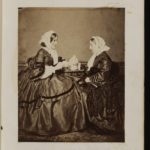Jane Elizabeth (‘Jeanie’) Senior (1828-1877) by George Frederick Watts, 1857-8
Jane ‘Jeanie’ Elizabeth Hughes, Mrs Nassau John Senior (1828-1877) by George Frederick Watts OM, RA, (London 1817 – Compton 1904), 1857-58. A full-length portrait of female, turned to right, in an informal blue bell-shaped dress with no undersleeves and low-cut neck, kneeling on crimson armchair, watering lilies of the valley on gilt console table. Flowers and carafe in foreground to right; in the background green wallpaper with floral pattern.
Watts’ best known portraits are the ‘Hall of Fame’ series; a collection of serious, honest, head-and-shoulders paintings of great Victorians, mostly male, such as William Morris. He regarded portraiture as less important than his morally uplifting and symbolic works such as Time, Death and Judgement. But portraits such as Mrs Nassau Senior also rely heavily on symbolism.
Watts is not primarily thought of as a portrait-painter, and when he is, it is for the high seriousness and painful honesty of the portraits comprising his ‘Hall of Fame’ (1846 onwards -part of a memorable installation at Bodelwyddan Castle). He himself set a low estimate on portraiture, by comparison with the rendition of abstract and morally uplifting conceptions. Yet almost the first record of his artistic activity is of his earning a living at the age of sixteen, by making pencil or chalk portrait drawings at five shillings a time; whilst perhaps his most celebrated portrait of all is ‘Choosing’, that of his child-bride, the actress Ellen Terry, making the choice between showy but scentless camellias and a humble clutch of sweet-smelling violets held to her heart (around 1864 in National Portrait Gallery).
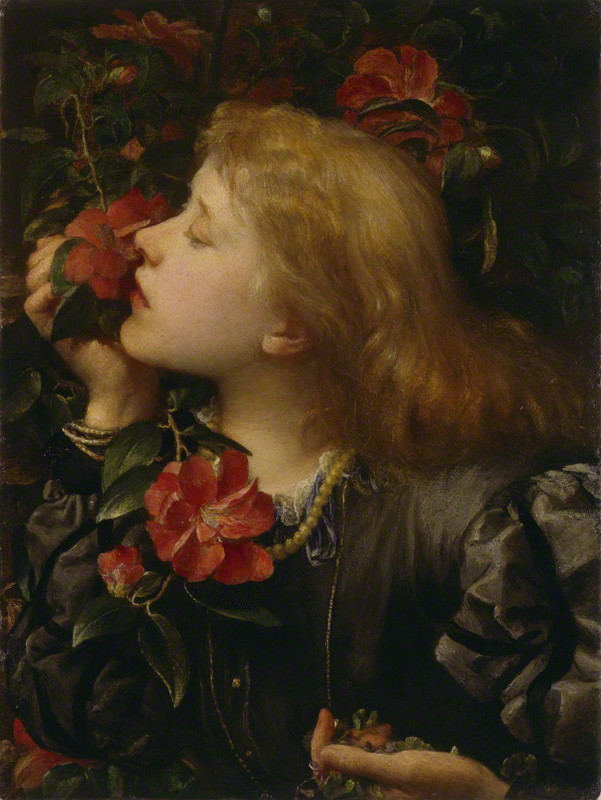
There was clearly some special significance for Watts in the association of women with flowers, for it is the unusual action of watering lilies of the valley in a pot that he has used for his portrait of this other woman to whom he was – more happily – devoted, Mrs Nassau Senior. She was the daughter of the author and artist John Hughes of Donnington Priory (1790-1857; although his mother was the daughter of a Reverend George Watts, there was no connection with the painter’s family), and thus the younger sister of Thomas Hughes (1822-96), Christian Socialist, founder of the Working Men’s College, and author of Tom Brown’s Schooldays.
In 1848 she was married to Nassau John Senior (1822-1891), who should perhaps be known as Nassau Senior Junior, since he was the son of the celebrated economist and creator of the 1834 Poor Law, Nassau William Senior (1790-1864). He was described by Ellen Twistleton as: “not one of the souls that Nature tried her finest touch on. At the bottom of everything, there is a little coarse commonplaceness about him ….” . With such family connections, it is unsurprising that she too devoted herself to social causes, becoming the first female Inspector of Workhouses and Pauper Schools (1874), and the founder of the Association for Befriending Young Servants. She also helped Octavia Hill, co-founder of the National Trust, with the accounts of her housing schemes .
Watts’s friendship with ‘Jeanie’ Senior began when he was living as the house-guest of the Prinseps at Little Holland House, in Kensington. Watts’s second wife, Mary Fraser-Tytler, rather surprisingly claims in her memoir of him , that it was “her naturally bright and spontaneous out-of-door nature” that appealed to him, which does not seem to correspond either to his ideal of female friendship or to his use of her as a sounding-board for the whole series of letters setting out his physical and spiritual afflictions, that he wrote to her up to the time of her premature death. Rather, it was their joint concern to do good – he through his art, she by practical action – combined with her physical attractiveness, that drew him to her. Her chief physical attraction was her “rippling golden hair” – that self-same enchantment that had helped to draw him to Ellen Terry, whom Mrs Stirling so memorably describes once, as she “loosened the pins from her hair, which tumbled about her shoulders like a cloak of shining gold” , when bored on a visit to the Spencer-Stanhopes whilst she was still married to Watts.
When painting his frescoes for Lord Somers in Carlton House Terrace in 1856, the painter even wrote to ‘Jeanie’ Senior, asking her “to lend me your hair …. and a hand or an arm occasionally”. Nor is it only the golden hair that links the portraits of Ellen Terry and ‘Jeanie’ Senior: the outstretched, yearning attitude of their heads is also strikingly similar, showing off – as Mrs Russell Barrington says of ‘Choosing’ – “a beautiful fair girl’s head and a perfect throat stretching forward” . Significantly, these features – the throat and its stretching – appear to have been accentuated in the painting, by comparison with the pencil study for the head of the portrait alone .
Just as Watts’s portrait of Ellen Terry is, as its title indicates, also a moral allegory expressed through the language of flowers, so is ‘Jeanie’ Senior’s. In giving her lilies of the valley to water, in a rich pot on a fantastically ornate plinth, and by scattering, as if rejected, cut flowers – including an arum lily – in the foreground, Watts appears to be setting up a deliberate contrast between the natural simplicity of the growing lilies, and the richness, profusion, and artifice with which they are surrounded. The inclusion, not just of the glass carafe she waters with, but also of the clear crystal jug of water in the foreground, suggests both purity and temperance; whilst Watts himself subsequently told Mrs Barrington that, by showing ‘Jeanie’ Senior in the act of “watering and bending over her flowers with loving care, …. he had tried to suggest …. her beneficent gracious nature” .
Nor was it only Mrs Senior whom Watts painted at this time; he also painted another full-length of her daughter, Miss Senior, “surrounded in her portrait by the beautiful sky and the grand laurel leaves, put in as the great Venetians would have painted them”, and her mother, Mrs Hughes, silhouetted against an endless expanse of landscape . He also later painted her only son, Walter, as a gift to his mother, just two years before she died . Curiously, it is the picture of her mother – which is, if anything, more reminiscent of the portraits of Sir William Blake Richmond – and not this, that both Mrs. Barrington and Wilfrid Blunt describe as showing a Pre-Raphaelite side to Watts.
Although never a Pre-Raphaelite (and indeed, repudiated for a time by Ruskin for that reason) Watts was susceptible to the influence of its members. At no time more, perhaps, than when he was painting the present portrait – with its curious premonitions of Holman Hunt’s Isabella and the Pot of Basil (1867, Laing Art Gallery, Newcastle-upon-Tyne) – at the same time as working on his fresco of Justice at Lincoln’s Inn (1853-59), executed in true fresco, as the Pre-Raphaelites themselves insisted on, and using Holman Hunt as the model for King Ina; and as he was sending off his assistant, Roddam Spencer Stanhope, and his hosts’s son, Val Prinsep, to assist with the Pre-Raphaelites’ own great scheme of fresco-decoration, the murals of the Oxford Union, which he described as “plunging him [Prinsep] in the Pre-Raphaelite Styx” .
He was further influenced at this period by Pre-Raphaelite techniques of oil-painting, having discussions with Rossetti, Millais, and perhaps Ruskin, on the respective advantages of various paint mediums; and for some years, under Rossetti’s influence, painting his pictures with copal varnish as a medium, including this one . Only later did he go over to benzoline, and – ultimately – a special preparation of petroleum made up by John Bell & Co., and called by them rock oil, with a small admixture of linseed oil. The result of these influences was, as his widow says , that the portrait of Mrs Nassau Senior is “brilliant in colour, and as delicate in handling as a miniature” – two of the distinguishing characteristics of Pre-Raphaelite painting.

Jane Nassau Senior (1828–1877) was Britain’s first female civil servant, and a philanthropist. She was co-founder of the Metropolitan Association for Befriending Young Servants (MABYS). Senior was born Jane Elizabeth Hughes at Uffington on 10 December 1828, daughter of John Hughes and the only sister of the author Thomas Hughes and five other brothers.
Senior’s relief work with material aid for the victims of the Franco-Prussian War of 1870 supported the National Society for Aid to Sick and Wounded in War. She was involved directing the practical work of handling donations, and the Society was the forerunner of the British Red Cross.
Work with impoverished children in Surrey led to Senior’s appointment in 1873, as an assistant inspector of workhouses. This post was given to her by James Stansfeld, against civil service opposition. The goal of the post was a Civil Service Report, which she framed as covering both pauper girls as school children, and their histories after school. When the Report appeared in 1875, the 1874 general election having intervened, it was the subject of heavy criticism by Carleton Tuffnell, acting in concert with The Times.
A meeting called by Thomas Vincent Fosbery in May 1874, at Lambeth Palace, brought together Elizabeth Browne, wife of Harold Browne the bishop of Winchester, Senior, Catharine Tait, wife of Archibald Tait, and Mary Elizabeth Townsend (1841–1918). They agreed to go about setting up the Girls’ Friendly Society, founded on 1 January 1875. MABYS was founded in 1876, to support young single servant girls, with a different group, Senior not finding enough common ground with the senior Anglicans.
G. F. Watts the artist had become a confidant of Jane Senior by the mid-1850s; they corresponded, and most of the letters have been destroyed. Octavia Hill, governess for a time to the children of Thomas Hughes, became a close friend. Senior was a friend and correspondent of the novelist George Eliot.
In Clapham, Senior knew Marianne Thornton, figure of the Clapham Sect and daughter of Henry Thornton, and her niece Henrietta Synnot, both of whom were involved in local schooling. Synnot became her assistant. Caroline Stephen made a very positive impression, and was an influence for the future. In the aftermath of the “Eyre controversy”, she made a point of inviting Emelia Russell Gurney, wife of Russell Gurney, to show her Jamaica sketches.
In the early 1870s Senior worked with Henrietta Rowland, teaching literacy in Whitechapel. Another associate of this period was Menella Bute Smedley, following up on girls who had left workhouse schools. For MABYS, Senior called on Bessie Belloc, Barbara Bodichon and Mrs. Knox for support.
Jane married Nassau John Senior, son of Nassau William Senior, on 10 August 1848 at Shaw Church. Her husband was a barrister, but failed to make more than a desultory career in the law. From 1860 they lived in Clapham, taking lodgers.
The marriage was unhappy. They had a son Walter Nassau (1850–1933). He married Mabel Barbara Hammersley, daughter of Hugh Hammersley and his mother’s friend Dulcibella Eden, in 1888.
Dorothea Murray Hughes (1891–1952), daughter of Senior’s brother Hastings Hughes, was a nurse and aid worker. She wrote Jane Elizabeth Senior: A Memoir (1915).
She died of ‘cancer of the womb’ and exhaustion on 24 March 1877, aged 48; and is buried in Brookwood Cemetery in Surrey.
The following article was published shortly after Janie Senior’s death in 1877.
RECOLLECTIONS OF THE HUGHES FAMILY
By Walter Money F. S. A.
The love of associating places with persons and persons with places is deeply ingrained in the nature of everybody who has something in him or her higher and better than plain prose and dry matter of fact. This circumstance may therefore plead an excuse for again referring to the old Priory when the property of ‘Pater Hughes’, who probably through some mystic or magic spell unknown and unsuspected by himself was first led to seek a home in the charming spot watered by the little river Lambourne, where the white-robed Maturines so long lived under English rule – a small community, whose house and church fell at the hands of destroyers of baser mould in the days when many of the noblest edifices in the country were ruthlessly swept away.
But of all the associations connected with the Priory there are none more thoroughly deserving remembrance than that it was the early home of that beautiful and accomplished lady known as Jeanie Hughes, the light and the pride of the village of Donnington,
‘A lovely lady, garmented in light
From her own beauty.‘
The daughter of ‘Pater Hughes’ and sister of ‘Tom’ (the author of ‘Tom Brown’s Schooldays’), Jeanie (her full name was Jane Elizabeth), was born at Uffington on the 10th December, 1828. Her education was conducted under the supervision of her father – one of the most versatile men of his day, – and from her earliest years Jeanie, who had inherited talent and beauty, resolved to employ her gifts to advantage, and to practice the virtue of self-reliance. But at the same time she did not neglect the lighter side of life, and showed great skill at the local archery meetings in which her father was the leading spirit, and she had a merry children’s party at the Priory.
In 1848 – 10th August – Jeanie married, at Shaw Church, Mr. Nassau John Senior, and in that interesting book, ‘Many Memories of Many People’, written by Mrs. Simpson, Mr. Senior’s sister, there is a description of ‘the charming young bride’, whom the authoress calls ‘the brightest ornament of our house’. Many were the descriptions of her personal appearance. A lady who knew her intimately writes:
‘She had the most lovely golden wavy hair, very long, and always looking as though the sun was shining upon it. She had a very earnest face, bright complexion, and clear blue eyes which seemed to look you through.’
Another says:
‘She was the most fascinating woman I ever met. The beauty of her expression, the sweetness and richness of her voice (in speaking as well as singing), and the charm of her manner combined to make her unlike anyone else.’
Again, a friend who lived with her for years writes:
‘I never look back on her as an ordinary woman who lived in this world. Her beauty of form and character always seemed to me as something not of this world at all. I do not believe that any man or woman ever gave out such marvellous influence as she did; and this not to a few, but to everyone and every class of person. All seemed as if they must and did adore her.‘
Before leaving the description of her personal appearance, which is not at all overdrawn, and we can vividly recall, allusion must be made to the portrait of her by Mr. G. F. Watts, R. A. and exhibited in the academy in 1859. Most wonderfully in this portrait does her golden hair stand out against the green background, and the whole picture is of such beauty that there is no wonder that it has several times been exhibited since it first appeared.
In this brief sketch we have only space to mention a few of the many philanthropic works with which Mrs. Senior so indefatigably identified herself. The sufferings of the soldiers in the Crimea touched her deeply, and she was found among the hardest workers of Miss Stanley’s assistants in sending out supplies.
Miss Octavia Hill [founder of The National Trust], too, numbered her amongst the best of her fellow-workers in various charitable undertakings, while during the Franco-Prussian war of 1870-1 she was busily occupied in the London offices of the Red Cross Society, whose medal she afterwards received.
In 1873 Mrs. Senior was selected by the President of the Local Government Board as assistant-inspector (afterwards Inspector) of Workhouses, and was the first woman to hold the office, which she filled with distinguished and business-like ability. She had in a supreme degree that which Carlyle calls the first quality of genius – an immense capacity for taking trouble. It should be remembered to her honour that she was the founder [one of the founders] of the Girls’ Friendly Society and the Metropolitan Association for Befriending Young Servants, both of which schemes have had results of a most wide-reaching and beneficial kind, and the girls of England owe an incalculable debt to the unceasing toil and loving forethought of Mrs. Nassau Senior.
It is left to speak of her splendid voice. ‘She filled our house with music’ says Mrs. Simpson. She was the first to try the capacities of the Albert Hall, and her voice amply filled the mighty space.
‘To hear her sing was an inspiration,’ says a friend, ‘and she left her character upon her songs in a remarkable way. Nothing she liked better than singing to a room full of working men, while it has been said she could hold the most cultivated audience enthralled.’
A story is told that when one day visiting with a friend in the East of London they came upon two women fighting in the middle of a ring of spectators. There was no possibility of separating them, and Mrs. Senior’s friend suggested she should sing. She immediately went to a doorway and there stood and sang “Angels, ever bright and fair.” The effect was marvellous – all were attracted to her and the fight at once died out. Another time she used to go and sing to the navvies while they were at breakfast. ‘They must have thought,’ says the narrator of this incident, ‘that an angel had come amongst them.’
As long as health and strength remained Mrs. Senior took the greatest interest in every movement which had for its object the social, physical and moral improvement of the world in which her lot was cast. In 1874 the breakdown came, when her mother, Mrs. Hughes, took a house in the Isle of Wight, and there Mrs. Senior went about in a chair for a year or two and sketched, and had the delight of Watts and Tennyson as friends and neighbours. Now there came a little more strength and the return to London with some resumption of work. But it was too much. She fell asleep on the 24th March, 1877. As one writes of her,
‘Surely a more beautiful life has scarcely ever been lived. Its very brevity seems almost in keeping. It was a concentration of sweetness and beauty which could, one would fancy, hardly have lasted longer than those 49 short years.’
If any lady of the 19th century, in England or abroad, could have been allowed to put in a claim for the credit of not having lived in vain, that woman, we honestly believe, was Mrs. Nassau Senior.
Jane Elizabeth Senior
In Memoriam
Not for the bright face we shall see no more,
Not for the sweet voice we no more shall hear;
Not for the heart with kindness brimming o’er,
Large charity, and sympathy sincere.
These are not things that ask a public pen
To blazon its memorial o’er her name;
But, that in public work she wrought with men,
And faced their frowns, and over-lived their blame.
Yet never swerved a hair’s breadth from the line
Of woman’s softness, gentleness and grace;
But brought from these an influence to refine
Rough tasks and squalid, and there leave its trace.
Honour to him who in a sneering age,
Braved quip and carp and cavil, and proclaimed
A woman’s fitness pauper needs to gauge,-
In purpose strong, in purity unshamed.
For paupers too have sex: the workhouse walls
Hold mothers, maidens, and girl-babes, on whom
A woman’s eye with woman’s insight falls,
Sees its own ways for sunlight to their gloom.
And so this noble and brave lady turned
From glad life, luxury and thronging friends
That hung on her sweet voice, and only yearned
To guide her holy work to useful ends.
But Death to Life begrudged her, striking down
The task unfinished from her willing hands,
Leaving to women yet to come the crown
Of her left life’s-work, that for others stands.
Then lay and leave her in her quiet grave,
Where the sun shines undimmed, the rain falls clear,
And birches bend, and deodoras wave
Evergreen arms of welcome o’er her bier.
Published in ‘Punch’ in 1877.
Read more about Jeanie on this link here.
source: The National Trust, Peerage

